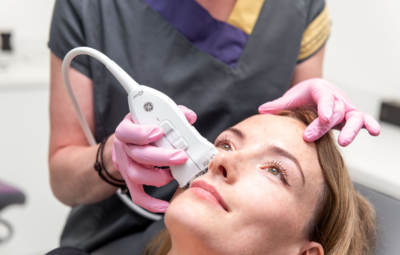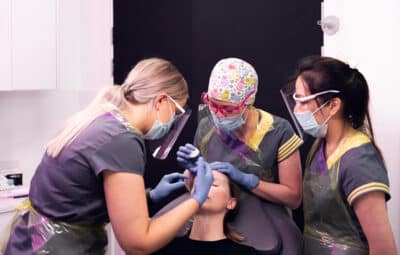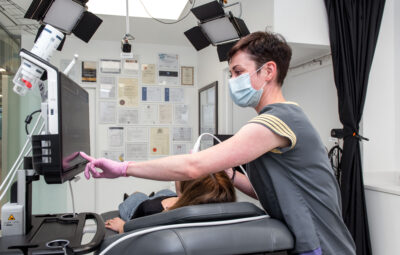
Hyaluronic Acid Dermal Fillers Explained: A Complete Guide
30 October 2025
In this post:
- Hyaluronic acid is a naturally occurring molecule in the body that plays crucial structural and biologic roles in tissue hydration and volume.
- Crosslinked HA fillers offer longevity, biocompatibility, and reversibility, making them ideal for aesthetic treatments.
- Different HA fillers vary significantly in crosslinking density, particle size, viscosity, and longevity, requiring careful product selection.
- Proper training in facial anatomy and injection technique is essential for safe HA filler treatments and complication prevention.
Over 6.3 million hyaluronic acid dermal filler treatments were performed worldwide in 2024, representing an increase of 5.2% in the previous year. Hyaluronic acid (HA) fillers now account for approximately 80% of all filler treatments globally.
With numbers like these, you’d think we all understand exactly what hyaluronic acid is and how it works. Yet many beginner injectors, and certainly most patients, think of HA fillers as simple volumising products without appreciating the sophisticated science behind them.
Understanding what you’re injecting is the foundation of a safe, effective practice that produces consistent results and avoids complications. In this blog post, we’ll explore just how hyaluronic acid dermal fillers work and why they’re the most widely used filler type.
Enjoy this preview into our online lip filler course. To view the full video and enrol in the course, click here.
What is Hyaluronic Acid?
The name hyaluronic acid comes from the Greek word ‘hyalos,’ meaning glass, a reference to its clear, glassy appearance. First isolated from cow eyes in 1934 by scientists Karl Meyer and John Palmer, HA was used in ophthalmic surgery by the 1950s. Skincare products containing HA emerged in the 1980s, and HA dermal fillers became available in the EU during the 1990s before receiving FDA clearance in the United States in the 2000s.
Hyaluronic acid is a naturally occurring glycosaminoglycan (essentially a sugar molecule) found throughout the human body. In a 70kg adult, approximately 15g of HA exists at any given time, with over half concentrated in the skin. The rest appears in the synovial fluid, the vitreous body of the eye, and the areas subject to friction like tendons and joints.
What makes HA so valuable is its remarkable water-binding capacity. The molecule can bind up to 1000x its own weight in water, contributing to its viscoelastic properties and ability to maintain structure and volume in tissues.
As Dr MJ Rowland-Warmann, founder of the Smileworks Aesthetic Training HUB, explains: ‘Thinking that hyaluronic acid is simply this miracle substance that comes in syringes and fills faces is not going to be good enough when you want to be taken seriously as a medical professional.’
Here’s something most people don’t know: approximately one-third of the body’s natural hyaluronic acid is turned over daily. The production of HA is regulated by synthetases, whilst its degradation is controlled by hyaluronidases. In its native form, HA degrades within hours, which is why your body constantly synthesises new supplies.
How Hyaluronic Acid Works as Dermal Filler
If natural hyaluronic acid degrades within hours, how can dermal fillers last anywhere from six months to two years? The answer lies in crosslinking.
Sodium hyaluronate (the material used in HA fillers) undergoes a manufacturing process that chemically crosslinks the hyaluronic acid molecules using BDDE (1,4-butanediol diglycidyl ether). This crosslinking stablises the HA structure, dramatically extending its longevity in tissue and preventing rapid enzymatic breakdown. The degree of crosslinking determines the filler’s stiffness, resistance to degradation, and ultimately how long it lasts in the body.
HA’s role in the body can be divided into structural and biological functions.
Structural roles include water retention, which maintains tissue hydration and structure; viscoelasticity, where HA acts as a shock absorber; and regulation of water content in the dermis.
Biologic roles are more complex and directly relevant to injection outcomes. Hyaluronic acid exists in different molecular weights, each with distinct biological effects.
- High molecular weight HA: anti-inflammatory, reducing cytokines and interleukins in tissues.
- Low and medium molecular weight HA: strong pro-inflammatory properties and recruit inflammatory cells like T-cells to the injection site.
This distinction matters clinically. When HA fillers begin to degrade in the body, they break down into lower molecular weight fragments, which can trigger inflammatory responses. Understanding this mechanism helps explain why some patients experience delayed inflammatory reactions weeks or months after treatment.
Because bacterial and human hyaluronic acid are essentially identical, HA for medical use can easily be obtained through bacterial fermentation. This biocompatibility means HA fillers don’t require allergy testing and can be used immediately.
Types of Hyaluronic Acid Fillers & What Makes Them Different
One of the most significant misconceptions in aesthetic medicine is that all hyaluronic acid fillers are essentially the same. With over 160 types of dermal fillers currently available worldwide from more than 50 companies, the variations in formulation and resulting properties are substantial.
Dr MJ warns practitioners directly: ‘Choosing the wrong filler can have disastrous consequences. Lumpy lips, puffy eyes, and swollen cheeks are just mild examples. And those consequences will signpost you as an amateur.’
Crosslinking Density & Technology
This determines the filler’s structural integrity and longevity. Brands like Juvederm use Vycross technology, which blends high and low molecular weight HA. Teoxane’s RHA technology uses long-chain HA with low BDDE concentration. Restylane employs OBT to vary firmness through different crosslinking densities.
Particle Size & Cohesion
This is what affects how the filler integrates into tissue and whether it stays where placed or spreads. High cohesion fillers remain intact and don’t migrate, making them suitable for structural applications. Low cohesion fillers spread more easily, working well for superficial applications.
Viscosity and Elastic Modulus (G prime)
This indicates how the filler responds to pressure. Higher G prime values mean stiffer gels that provide more lift, suitable for deeper placement in areas like cheeks or jawline. On the other hand, lower G prime values indicate softer gels appropriate for dynamic areas like lips.
Longevity Variations
This is a significant factor, one that depends on the specific formulation, injection depth, and treatment area. Results in the lips may last six months, whilst those in the nasolabial folds can last for 9-12 months or longer. Some volumising fillers placed deeply in the cheeks can last up to 24 months.
The clinical implications are clear: there is no universal hyaluronic acid dermal filler that works optimally for every indication. Selecting the appropriate product requires understanding facial anatomy, the characteristics of available products, and how different formulations behave in various tissue planes.
Who Should Inject Hyaluronic Acid FIllers?
Hyaluronic acid fillers are generally considered safe when used appropriately by trained practitioners. Common side effects include temporary swelling, bruising, redness, and tenderness at injection sites that usually resolve within a few days.
More serious but less common complications include vascular occlusion (blockage of blood vessels), which can lead to tissue necrosis or, in rare cases, filler blindness; allergic reactions; persistent lumps or nodules; infection; and migration of product beyond the intended treatment area.
One of HA’s significant safety advantages is reversibility. Hyaluronidase can dissolve hyaluronic acid fillers in cases of complications, overcorrection, or patient dissatisfaction. This safety net doesn’t exist for permanent or semi-permanent fillers.
But here’s where the conversation becomes critical: in the UK, current 2025 regulations mean that legally, anyone can inject dermal fillers regardless of their training or medical background. This regulatory gap has led to a proliferation of inadequately trained practitioners offering treatments, often with dangerous consequences.
Understanding facial anatomy isn’t optional for safe dermal filler injection. The difference between a practitioner who produces consistent, natural results and one who creates complications often comes down to training. Knowing where to place product, at what depth, at what speed, and in what volume requires practical experience built on a foundation of anatomical knowledge.

Master Hyaluronic Acid Dermal Filler Injection
Hyaluronic acid dermal fillers are sophisticated medical devices with complex mechanisms of action, not simple cosmetic products.
At the Smileworks Aesthetic Training HUB, we prepare practitioners for the real-word challenges of dermal filler injection through comprehensive training that bridges theory and practical experience. Our Foundation Botox & Lip Filler course establishes proper technique from day one.
For advanced practitioners, our Foundation Facial Ultrasound Course and our Advanced Facial Ultrasound Course take prevention to the next level. When you can visualise anatomical structures in real time, injection precision improves and complication rates drop dramatically.
For those looking for more in-depth training, we recommend booking a one-to-one mentoring session with Dr MJ. These sessions are 100% customisable, and you’ll receive personalised instruction based on your skill level and goals.
Join us at the HUB today. Let’s shape the future of aesthetic medicine together and ensure safe, effective, and transformative results for every patient.
Want to try out our courses before committing? Take advantage of our free trial for a taste of what learning at the HUB is like.
Related blog posts:





